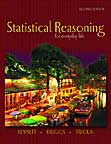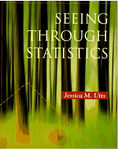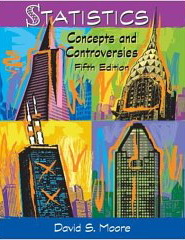|
|
|
Statistical Reasoning
focuses primarily on the influence of chance in sample data (sampling
distributions and statistical
inference) while statistical
literacy focuses primarily on the social construction of statistics, the
influence of confounding in population data and measuring associations
between groups. Given a primary focus on the influence of chance in sample data, Statistical Reasoning focuses slightly less on chance and
statistical inference and considerably more on measuring and modeling associations (e.g.,
correlation and causation) between factors within a group than does a traditional statistics course.
[This page is not reviewed or approved by
the ASA, MAA or by any of the authors]
"Statistical reasoning may
be defined as the way people reason with statistical ideas and make sense of
statistical information (Garfield
and Gal 1999). This involves making interpretations based on sets of
data, graphical representations, and statistical summaries. Much of
statistical reasoning combines ideas about data and chance, which leads to
making inferences and interpreting statistical results. Underlying this
reasoning is a conceptual understanding of important ideas, such as
distribution, center, spread, association, uncertainty, randomness, and
sampling."
Garfield, 2004,The Challenge of Developing Statistical Reasoning.
These are general education
level textbooks that focus more on teaching statistical reasoning.
Hard Copy (pdf) of this
page (w/o pictures)
|



Seeing Through
Statistics:
Jessica Utts:
Fourth Edition 2014.
Table
of Contents
Statistical Reasoning: Table of Contents
(5th ed.2018)
by Jeffrey O. Bennett
, William Briggs
and Mario Triola
Statistical Reasoning For
Everyday Life
Addison-Wesley
by Jeffrey O. Bennett
, William Briggs
and Mario Triola (2nd ed., 2003)
Data Sets and
Links for web projects
Table of Contents
-
Speaking of Statistics: 1.1 What
Is/Are Statistics? 1.2 Sampling, 1.3 Types of Statistical
Study, 1.4 Should You Believe a Statistical Study? Focus on
Sociology: Does Daycare Breed Bullies? Focus on Public
Health: Is Your Lifestyle Healthy?
-
Measurement In Statistics: 2.1 Data
Types and Levels of Measurement, 2.2 Dealing with Errors, 2.3
Uses of Percentages in Statistics, 2.4 Index Numbers Focus on
Politics: Who Benefits from a Tax Cut? Focus on
Economics: Does the CPI Really Measure
Inflation?
-
Visual Displays of Data: 3.1 Frequency
Tables, 3.2 Picturing Distributions of Data, 3.3 Graphics in the
Media, 3.4 A Few Cautions About Graphics, Focus on History:
Can War Be Described with a Graph?, Focus on Environment:
How Much Carbon Dioxide Is in the
Atmosphere?
-
Describing Data: 4.1 What is Average?,
4.2 Shapes of Distributions, 4.3 Measures of Variation, Focus on
the Stock Market: What's Average About the Dow?, Focus on
Economics: Are the Rich Getting Richer?
-
A
Normal World: 5.1 What is Normal?, 5.2
Properties of the Normal Distribution, 5.3 The Central Limit
Theorem, Focus on Education: What Do SAT Scores Mean?,
Focus on Psychology: Are We Smarter
Than Our Parents?
-
Probability in Statistics: 6.1 The
Role of Probability in Statistics: Statistical Significance, 6.2
Basics of Probability, 6.3 Probabilities with Large Numbers, 6.4
Combining Probabilities, Focus on Social Science: Are
Lotteries Fair? Focus on Law: Is DNA Fingerprinting
Reliable?
-
Correlation and Causality: 7.1 Seeking
Correlation, 7.2 Interpreting Correlations, 7.3 Best-Fit Lines
and Prediction, 7.4 The Search for Causality, Focus on
Education: What Helps Children Read?, Focus on Public
Health: What Do Disease Clusters Mean?
-
From Samples to Populations: 8.1
Sampling Distributions, 8.2 Estimating Population Means, 8.3
Estimating Population Proportions, Focus on Media: Did NBC
Lose $66 Million to a Nielsen Sampling Error?, Focus on
Literature: How Many Words Did
Shakespeare Know?
-
Hypothesis Testing: 9.1 Fundamentals
of Hypothesis Testing, 9.2 Setting Up Hypothesis Tests, 9.3
Hypothesis Tests for Population Means, 9.4 Hypothesis Testing:
Further Considerations, 9.5 Hypothesis Testing: Population
Proportions, Focus on History: Where Did Statistics Begin,
Focus on Agriculture: Are Genetically Modified Foods
Safe?
-
Further Applications of Statistics:
10.1 Ideas of Risk and Life Expectancy, 10.2 Statistical
Paradoxes, 10.3 Hypothesis Testing with Two-Way tables, Focus on
Criminology: Can You Tell a Fraud When You See One?,
Focus on Education: What Can a
Fourth-Grader Do with Statistics?
Seeing Through
Statistics:
Jessica Utts
1st edition: 1995 Wadsworth Publishing.
2nd edition: 1999 Duxbury. 3rd edition: June 23,
2004 Duxbury.
Table of
Contents
-
Chapter 1: Principles of Reasoning. (1A) The Forces of Persuasion, An Overview of
Common Fallacies, (1B) Propositions: The Building Blocks of
Arguments, (1C) Arguments: Deductive and Inductive, (1D)
Analyzing Real Arguments.
-
Chapter 2. Statistical Reasoning. (2A) Fundamentals of Statistics, (2B) Should
you believe a Statistical Study? (2C) Basic Statistical
Graphs, (2D) Graphs in the Media, (2E) Causal Connections.
-
Chapter 4. Numbers in the Real World. (4A) Concepts of Numbers, (4B) Uses and
Abuses of Percentages, (4C) Putting Numbers in Perspective, (4D) Dealing With Uncertainty.
-
Chapter 5. Financial Management. (5A) The Power of Compound Interest, (5B)
Savings Plans (Annuities), (5C) Loan Payments, Credit Cards and
Mortgages, (5D) Income Taxes, (5E) Investments.
-
Chapter 7. Exponential Growth and Decay. (7A) Exponential Astonishment, (7B) Doubling Time and Half Life, (7C) Exponential Modeling, (7D) Real Population Growth.
-
Chapter 8. Probability: Living with the Odds. (8A) Principles of Counting, (8B) Fundamentals of Probability, (8C) Combining Probabilities, (8D) The Law of Averages, (8E) Probability, Risk and Coincidence
-
Chapter 9.
Putting Statistics to Work. (9A) Characterizing Data,
(9B) Linear Regression Models, (9C) Statistical Inference, (9D) Sample Issues in Statistical Research.
-
Chapter 10.
Mathematics and the Arts. (10A) Fundamentals of Geometry, (10B) Mathematics and Music, (10C) Perspective and Symmetry, (10D) Proportion and the Golden Ratio, (10E) Fractal Geometry.
-
Chapter 11.
Discrete Mathematics in Business and
Society. (11A) Network Analysis, (11B) The
Traveling Salesman Problem, (11C) Project Design, (11D) Voting. Does the Majority Always Rule?, (11E) Theory of Voting.
-
Chapter 12. The Power of Numbers. A few more topics. (12A) Balancing the Federal Budget, (12B) Energy: Our Future Depends on it, (12C) Density and Concentration, (12D) Logarithmic Scales: Earthquakes, Sounds and
Acids.
Concepts and Controversies
by David Moore (5th ed., 2000)
Table of Contents
-
Producing Data: 1 Where
do Data Come From? 2 Samples Good and Bad, 3 What do
Samples Tell Us, 4 Sample Surveys in the Real World, 5
Experiments Good and Bad, 6 Experiments in the Real World, 7
Data Ethics, 8 Measuring, 9 Do the Numbers Make Sense?
-
Organizing Data: 10 Graphs Good
and Bad, 11 Displaying Distributions with Graphs, 12 Displaying
Distributions with Numbers, 13 Normal Distributions, 14
Describing Relationships: Scatter plots and Correlation, 15
Describing Relationships: Regression, Prediction and Causation, 16 The Consumer Price Index and Government Statistics.
-
Chance: 17 Thinking about Chance, 18 Probability Models, 19 Simulation, 20 The House Edge:
Expected Values
-
Inference: 21 What is a Confidence Interval?, 22
What is a Test of Significance?, 23 Use and Abuse of Statistical
Inference, 24 Two-way Tables and the Chi-squared Test, 25
Inference about a Population Mean.
A Handbook of Statistical Literacy
by Patricia Cerrito Author of
The Importance, Empowerment
and Transformation of Statistical Analysis
Teaching Statistical Literacy by Peggy Cerrito in College
Teaching (Jan 1, 1999). Available at
HighBeam.
|
|

